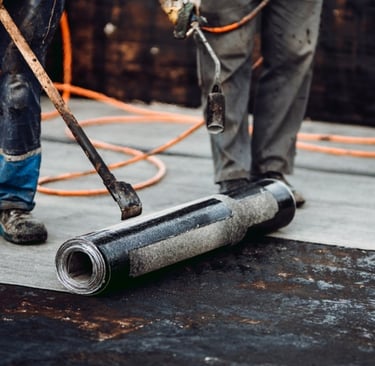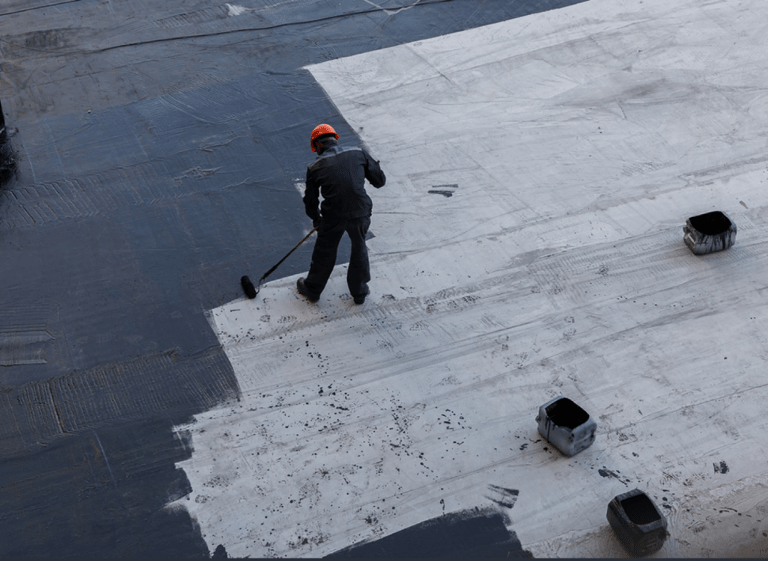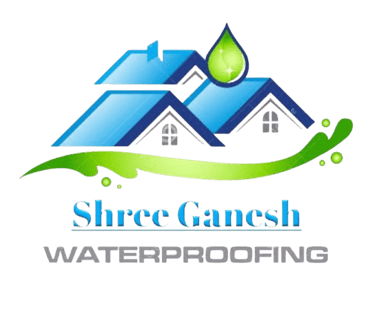3. Membrane Waterproofing:
Membrane waterproofing involves the application of a thin layer or membrane of waterproof material that forms a barrier against water penetration. These membranes are typically used to protect surfaces from water, moisture, and even harsh environmental conditions. Membrane waterproofing is highly effective for both horizontal (roofs, decks) and vertical (walls, foundations) surfaces. It’s widely used in both commercial and residential construction. Membrane waterproofing systems are flexible and provide excellent protection because they form a continuous, seamless layer that prevents water from penetrating, even through cracks or joints.


Membrane Waterproofing
Bituminous Membrane Waterproofing
Description: This is one of the most commonly used waterproofing methods, particularly for roofs and underground structures. Bituminous membranes are made of bitumen (asphalt or coal tar) and are typically reinforced with polyester, fiberglass, or other materials to enhance strength and flexibility.
Types:
Modified Bitumen: A type of bituminous membrane that has been modified with polymers (e.g., SBS or APP) for better flexibility and performance, especially in extreme weather conditions.
Self-Adhesive Bitumen Membranes: These membranes come with a sticky backing, making them easier to install without requiring hot-melt bitumen.
Applications: Commonly used for flat roofs, terraces, foundations, and basement walls. They are also used in areas exposed to high traffic and environmental stress.
Polyurethane Membrane Waterproofing
Description: Polyurethane membranes are liquid-applied and form a highly flexible, durable, and waterproof layer once cured. They are available in both single-component and two-component varieties, with the latter requiring mixing of two components before application.
Features: Polyurethane membranes are UV-resistant and perform well in areas with heavy foot traffic or in regions with extreme temperature fluctuations.
Applications: Ideal for roof waterproofing, balconies, terraces, basements, and wet areas in buildings such as bathrooms and kitchens.
EPDM (Ethylene Propylene Diene Monomer) Membrane Waterproofing
Description: EPDM is a synthetic rubber membrane used primarily for roofing. EPDM membranes are known for their excellent resistance to UV rays, ozone, and extreme temperatures. The membrane is typically black or white, with thickness ranging from 1.5 mm to 2.5 mm.
Features: It has a long lifespan, excellent flexibility, and a high degree of resistance to weathering and chemical exposure.
Applications: Commonly used in commercial roofing projects, flat roofs, and low-sloped roofs. Also used in areas requiring superior resistance to environmental stressors.
TPO (Thermoplastic Polyolefin) Membrane Waterproofing
Description: TPO is a single-ply roofing membrane that is made from a blend of polypropylene and ethylene-propylene rubber. TPO is heat-weldable and features a reflective surface that helps reduce cooling costs in buildings.
Features: TPO membranes are lightweight, durable, and have excellent UV resistance. They are also highly resistant to punctures and tears, making them ideal for areas exposed to extreme weather conditions.
Applications: Mainly used in commercial and industrial buildings, particularly for large flat or low-sloped roofs.
PVC (Polyvinyl Chloride) Membrane Waterproofing
Description: PVC membranes are made from plasticized polyvinyl chloride, a synthetic material known for its durability, resistance to chemicals, and low cost.
Features: PVC membranes are resistant to a wide range of chemicals, pollutants, and oils. They also provide excellent resistance to UV rays and extreme weather.
Applications: Commonly used in commercial roofs, terraces, basements, and parking decks. It’s also frequently used in industrial settings where exposure to chemicals is a concern.
Rubberized Asphalt Membrane Waterproofing
Description: This membrane combines the benefits of asphalt and rubber for waterproofing applications. It’s often used in areas with extreme weather conditions due to its excellent adhesion properties and flexibility.
Features: The rubberized asphalt layer is typically reinforced with a polymer or fabric to improve strength and performance.
Applications: Ideal for foundation waterproofing, under-slab applications, and tunnel waterproofing.
Advantages of Membrane Waterproofing
Seamless and Continuous: Membranes are applied as continuous sheets that eliminate the risk of leaks around joints, seams, or cracks, which makes them very effective in areas prone to water infiltration.
High Flexibility: Membranes, particularly bituminous and polyurethane-based ones, are highly flexible and can accommodate minor structural movements, which is especially important in areas with thermal or environmental shifts.
Durability: Membrane systems are long-lasting and resistant to damage from environmental factors such as UV rays, temperature fluctuations, and chemical exposure.
Low Maintenance: Once applied correctly, membrane waterproofing systems require minimal maintenance. Their long lifespan reduces the need for frequent repairs or replacements.
Quick Installation: Some types of membrane waterproofing (like self-adhesive bituminous membranes) are quick to install, reducing labor time and cost.
Aesthetic Appeal: Membranes like TPO or PVC can be used in visible areas, such as flat roofs, without compromising the aesthetics of a building, especially with reflective or decorative finishes.
Applications of Membrane Waterproofing
Roofing: Membrane waterproofing is often the preferred method for flat roofs or low-slope roofs. Membranes can provide protection from heavy rainfall and leaks, extending the lifespan of the roofing structure.
Foundations and Basements: Membranes are used in basement walls and foundations to protect against water ingress from the surrounding soil, especially in areas with high water tables.
Terraces and Balconies: Membranes are highly effective at preventing water damage to exterior spaces like balconies and terraces, where water can seep into the building.
Swimming Pools: Waterproof membranes are often used to line swimming pools, ensuring they retain water without leaks.
Parking Decks: Due to the heavy load and exposure to weather, parking decks often utilize durable waterproof membranes for long-term protection against water penetration.
Process of Membrane Waterproofing
Surface Preparation: The surface to be waterproofed must be clean, dry, and free of any debris, oils, or contaminants. Any cracks, joints, or holes should be repaired prior to applying the membrane.
Application of Membrane:
For bituminous membranes, the material is typically applied in sheets, which are either hot-applied or self-adhesive.
Polyurethane, EPDM, TPO, and PVC membranes are usually liquid-applied or come in rolls that are heat-welded or adhered to the surface to form a continuous layer.
Seaming and Edge Finishing:
For sheet membranes, seams should be tightly bonded or welded to ensure a continuous, leak-proof layer.
Proper edge treatment (flashing) is essential to ensure the membrane is secure and watertight.
Curing and Drying:
Membranes like polyurethane and liquid-based coatings need proper curing time to form a solid, watertight layer.
Inspection and Maintenance:
Regular inspection is recommended to check for damage or degradation from weather conditions. If any areas are compromised, re-coating or patching may be necessary.


